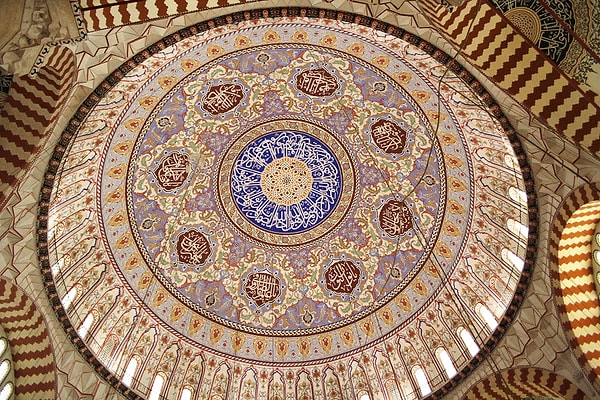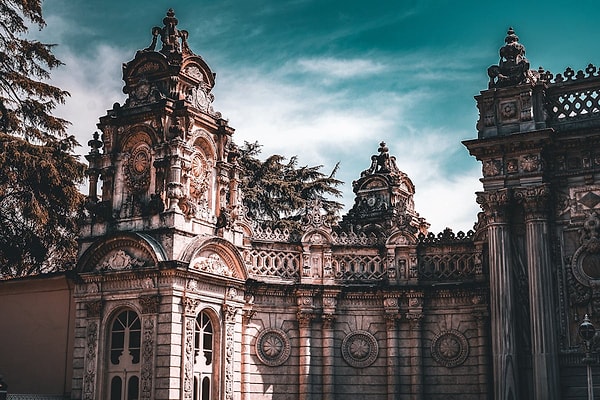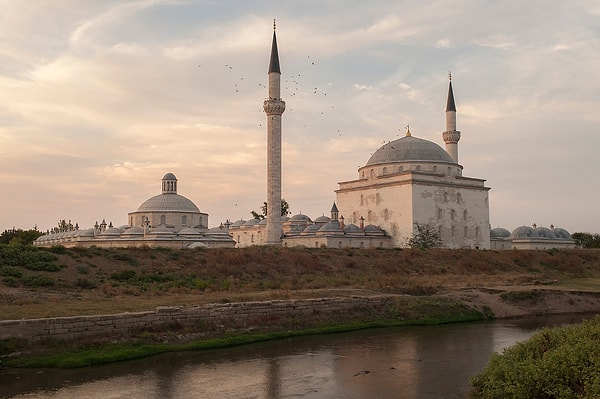Top 10 Magnificent Examples of Ottoman Architecture in Turkey
The Ottoman Empire... A civilisation that left deep traces in world history with its borders spanning three continents, its centuries-long reign and its structure that incorporated different cultures. The power and splendour of this great empire reach our day not only with its political and military achievements, but also with its unique works of architecture. Ottoman architecture, which offers a subtle synthesis of Byzantine, Seljuk, Iranian and Islamic art, continues to fascinate its visitors with its monumental structures that combine functionality and aesthetics.
In this article, we will take you on a time travel through Turkey and discover 10 majestic buildings that represent the pinnacle of Ottoman architecture, each telling its own story. These monuments stand out not only for their architectural genius but also for being iconic structures that shaped the skyline of the cities they are located in. If you are ready, let's start this amazing architectural journey!
1. Selimiye Mosque and Complex (Edirne)

Mimar Sinan's Masterpiece: Selimiye Mosque, located in Edirne, one of the capitals of the Ottoman Empire, is the culmination of Mimar Sinan's architectural genius, which he called “my masterpiece”. Built by Sultan Selim II, the mosque was constructed between 1568-1575.
Architectural Features: The most important feature that makes Selimiye unique is its huge single dome resting on eight columns. This dome draws attention both with the sense of completeness and spaciousness it provides to the interior and the monumental appearance it gives to the building when viewed from the outside. The four elegant minarets, the Iznik tiles in the interior, the marble minbar and the Hünkâr Mahfili (where the sultan prayed) are other important elements of the mosque. The complex also includes madrasas, darülhadis (hadith school), darülkurra (place for reading the Qur'an) and arasta (bazaar).
What to see: Experience the otherworldly atmosphere under the enormous dome inside the mosque. Find the inverted tulip motif (which, according to one rumour, represents the stubbornness of the landowner). Visit the other buildings of the complex, especially the Darülhadis Madrasah, which is now used as a Foundation Museum. Browse the local products in the arastada.
How to get there: The Selimiye Mosque is in the city center of Edirne and is easily accessible on foot. Edirne is easily accessible by bus from Istanbul and other big cities.
2. Suleymaniye Mosque and Complex (Istanbul)

Where Splendor and Elegance Meet: Süleymaniye, built on one of the seven hills of Istanbul, was built between 1550-1557 by Sinan the Architect on behalf of Suleiman the Magnificent. It is one of the most important symbols of Istanbul with its location dominating the city's skyline.
Architectural Features: It has a majestic exterior with its four minarets (two with three and two with two balconies) and stepped domes. Its interior is remarkable for its high dome, elegant stained glass windows, acoustics and simplicity. Süleymaniye is not only a mosque, but also a huge complex consisting of madrasas, a library, a hospital (darüşşifa), a bathhouse, an imarethane (soup kitchen) and tombs. These structures are a reflection of the Ottoman social state's approach to architecture.
What to see: Soak up the peaceful atmosphere of the mosque. Enjoy the view of the Golden Horn and the Bosphorus from the courtyard. Visit the tombs of Suleiman the Magnificent and his wife Hürrem Sultan. See the other buildings of the complex, especially the modest tomb of Mimar Sinan. Wander the historic streets around the mosque.
How to get there: It is located in the Fatih district of Istanbul, between Beyazıt and Eminönü. It can be reached on foot from the Grand Bazaar or the Spice Bazaar. Vezneciler Metro station or Beyazıt Tram stop are also within walking distance.
3. Topkapi Palace Museum (Istanbul)

The Heart of the Empire: Built by Mehmet the Conqueror in 1478, Topkapı Palace served as the residence of the Ottoman sultans, the administrative centre of the state and an educational institution for nearly 400 years. It was transformed into a museum with the proclamation of the Republic.
Architectural Features: Rather than a single monumental building, it is an organic complex of mansions, pavilions, apartments, courtyards and gardens spread over a large area. It consists of main sections such as Alay Square, Divan Square (with the Tower of Justice and Divan-ı Hümayun), Enderun Courtyard (Arz Chamber, Department of Holy Relics, Treasury Department) and Harem. Each section has different functions and architectural styles.
What to see: Explore the four courtyards of the palace. Visit the Treasury Room, where priceless jewels are displayed, the Holy Relics Room, where items belonging to the Prophet Muhammad are kept, and the Harem, the private living quarters of the sultans (separate tickets may be required). See the Divan-ı Hümayun and the Tower of Justice. Enjoy spectacular views of the Bosphorus, Golden Horn and Marmara Sea from different points of the palace.
How to get there: Located in Istanbul's Historic Peninsula, just behind Sultanahmet Square. It is a short walk from the Sultanahmet or Gülhane tram stops.
4. Blue Mosque (Istanbul)

Blue Elegance: Built between 1609-1617 at the order of Sultan Ahmed I by the architect Sedefkâr Mehmed Ağa, the mosque is known as the “Blue Mosque” in the Western world. It is located directly opposite the Hagia Sophia and is one of the most iconic buildings in Istanbul.
Architectural Features: It stands out with its six minarets, a first in Ottoman architecture. More than 20,000 blue-dominated Iznik tiles decorating its interior are the feature that gives the building its name. The large central dome is supported by half domes and columns. The large courtyard and stained glass windows in the interior also add to the beauty of the mosque.
What to see: Take a close look at the eye-catching Iznik tiles that cover the interior of the mosque. Watch the majesty of its six minarets from the outside. Feel the spaciousness under the central dome. Keep in mind that the mosque is still an active place of worship and pay attention to visiting hours (outside prayer times) and dress appropriately.
How to reach it: It is located in Sultanahmet Square in Istanbul. It is very close to the Sultanahmet tram stop. It is in the same area as the Hagia Sophia and the Topkapi Palace.
5. Dolmabahce Palace (Istanbul)

The Pearl of Westernisation: It was built by Sultan Abdülmecid between 1843 and 1856 by architect Garabet Balyan and his son Nigoğos Balyan during the late Ottoman Empire. Unlike Topkapi Palace, it consists of a single and large main building, more reminiscent of European palaces.
Architectural Features: It has an eclectic style blending Baroque, Rococo and Neoclassical styles with Ottoman architecture. The palace, which has a 600-meter dock on the shore of the Bosphorus, consists of three main sections: Selamlık (official affairs), Muayede Hall (ceremonies) and Harem (private life). The gold leaf, crystal chandeliers (one of the largest in the world is in the Muayede Hall), precious carpets and paintings used in the interior decoration are dazzling.
What to see: See the palace's majestic Muayede Hall and the huge crystal chandelier, a gift from Queen Victoria. Explore the Crystal Staircase, the Suffrage Hall and the Red Room. Visit the room where Mustafa Kemal Atatürk, the founder of the Republic of Turkey, passed away. Take photos in the palace garden and at the gates overlooking the Bosphorus.
How to reach: Located in Besiktas, Istanbul, on the banks of the Bosphorus. Kabataş tram stop is within walking distance. Beşiktaş ferry pier and bus stops are also nearby.
6. The Grand Mosque of Bursa

The Summit of Early Ottoman Architecture: It was built in Bursa, one of the first capitals of the Ottoman Empire, by Sultan Bayezid I (Yıldırım Bayezid) between 1396-1400 after the Victory of Niğbolu. It is one of the largest and most important mosques of early Ottoman architecture.
Architectural Features: It is the most monumental example of the “multi-domed” mosque type before the Mimar Sinan period. The rectangular structure is covered with twenty domes. The large fountain under the centre dome adds a unique atmosphere to the mosque. The huge calligraphy plates and wall writings in the interior are among the most beautiful examples of Islamic calligraphy. It also attracts attention with its two thick minarets and simple exterior.
What to see: Stroll around the fountain inside the mosque and feel the spiritual atmosphere under the domes. Examine the impressive calligraphy works on the walls. See the walnut wood pulpit made with the kündekari technique. Explore the historical bazaar area (Koza Han, Grand Bazaar) where the mosque is located.
How to reach: It is in the Bursa city centre. It is easily accessible on foot from the city square and the historical bazaar area.
7. Ishak Pasha Palace (Agri - Dogubayazit)

Fairytale Palace in the Shadow of the Mountains: This palace-complex, built on steep cliffs in the Doğubayazıt district of Ağrı, is one of the most magnificent and original examples of Ottoman architecture in Anatolia. Its construction was completed in the 18th century during the reign of İshak Pasha II of Çıldıroğulları (construction began in the 17th century).
Architectural Features: The palace, which does not adhere to a single architectural style, bears the influences of Ottoman, Seljuk, Persian, Baroque and Rococo art. It is more of a complex than a palace and includes a mosque, mausoleum, library, hammam, kitchen, dungeons, selamlık and harem sections. It is fascinating with its stonework, reliefs and monumental crown gates. Its location and view of Mount Ararat are also unique.
What to see: Tour the palace's two courtyards, mosque, divan hall and other sections. Notice the fine stonework and motifs on the walls. Watch the breathtaking view of the Doğubayazıt plain and Mount Ararat from the hill where the palace is located.
How to reach: It is about 5 km from the Doğubayazıt district centre. After arriving at Ağrı or Igdir airports, you can go to Doğubayazıt by road and take a taxi or minibus from the district centre to the palace.
8. Rustem Pasha Mosque (Istanbul)

The Most Elegant Form of Tile: Built by Rüstem Pasha, the son-in-law and grand vizier of Suleiman the Magnificent, to Mimar Sinan, the mosque was built between 1561 and 1563. It is located in Eminönü, close to the Spice Bazaar, above the shops.
Architectural Features: Despite its small size, it is famous for the unique Iznik tiles covering its interior and porticoes. These tiles, decorated with floral motifs such as tulips, hyacinths, carnations and geometric patterns, offer the most beautiful examples of the most brilliant period of Ottoman tile art. It is a modest but extremely elegant building with a single dome and a single minaret.
What to see: Examine in detail the magnificent Iznik tiles covering the interior walls, mihrab, pulpit and columns of the mosque. Admire the vibrancy of the colours and the variety of patterns on the tiles. Note its position on the platform formed by the shops below the mosque.
How to reach: It is located in Eminönü, Istanbul, within the Strawmakers Bazaar. It is very close to the Spice Bazaar and the New Mosque. It is easily accessible on foot from Eminönü ferry pier and tram stop. It is a bit like a hidden gem, accessed by stairs.
9. Şehzade Mosque (Istanbul)

Apprenticeship Work of Mimar Sinan: The mosque built by Sultan Suleiman the Magnificent in memory of his son Şehzade Mehmed, who died at a young age, to Mimar Sinan (1543-1548). In Sinan's own words, this building, which he called “my apprenticeship work”, is the precursor of his later great projects.
Architectural Features: It draws attention with its symmetrical plan in which the central dome is supported by four half domes. This plan became a model for many later mosques. With its two minarets with two balconies, elegant ornaments and balanced proportions, it is one of the early and mature examples of classical Ottoman architecture. Its complex includes a madrasah, imaret, tabhane (guest house) and the tomb of Şehzade Mehmed.
What to see: Observe the perfect symmetry and proportions of the mosque. Observe the fountain and porticoes in the courtyard. Experience the simplicity and tranquillity of the interior. Visit the mausoleums of important people, including Şehzade Mehmed and Rüstem Pasha.
How to reach: It is located in the Şehzadebaşı neighbourhood in the Fatih district of Istanbul. It is within walking distance to Vezneciler metro station and Laleli-Universite tram stop. It is also close to the Süleymaniye Mosque.
10. Sultan Bayezid II Complex and Health Museum (Edirne)

Healing Complex: This complex, built by Sultan Bayezid II between 1484-1488 by Architect Hayreddin, stands out especially with its Darüşşifa (hospital). It is located on the banks of the Tunca River.
Architectural Features: In addition to the mosque, madrasah, imaret, tabhane, bathhouse and bridge, it includes Darüşşifa, one of the most modern medical centres of its period. Darüşşifa is especially known for its innovative methods of treating the mentally ill with the sound of water, music and fragrances. It has a remarkable architecture with its hexagonal central hall and connected rooms.
What to See: Be sure to visit the Darüşşifa, which today serves as the Trakya University Sultan Bayezid II Complex Health Museum. See the medical instruments of the period, the treatment methods (especially the sections on treatment with music and water sound) and the animations describing medical education. Visit the mosque and other parts of the complex. Enjoy the peaceful atmosphere by the river.
How to get there: Edirne is located on the banks of the Tunca River, just outside the city centre. It can be reached by taxi or municipal buses from the city centre.
Keşfet ile ziyaret ettiğin tüm kategorileri tek akışta gör!

Send Comment